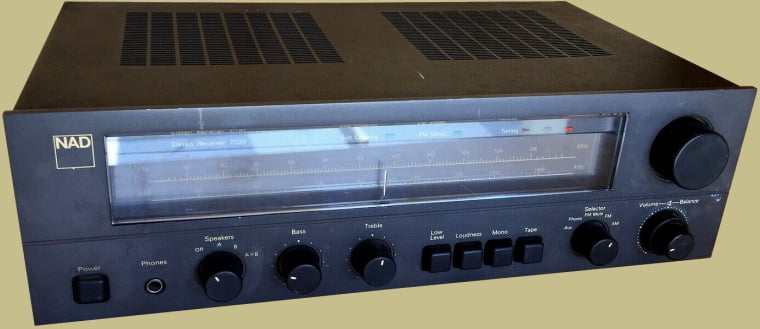
NAD, or New Acoustic Dimension, was formed in 1972 by Martin Borish and others. Bjorn Erik Edvardsen did most of the engineering. NAD’s initial concept was to build audio components that rivaled the performance of separates but that were affordable to younger buyers or audiophiles without large budgets. This NAD 7020 receiver fits that description perfectly. It’s basically similar to NAD’s famous 3020 amplifier but with an integrated tuner. The NAD 3020 is one of the best selling amplifiers of all time and it’s performance-to-cost ratio caused other audio manufacturers to scramble in order to compete with NAD. The 7020 came out in 1979, a little after the 3020, and packed a big performance punch that didn’t hurt the wallet.

You might think the NAD 7020 receiver (not to be confused with the later 7020e) is under powered at 20 watts per channel but the way the amp circuit is engineered gives it a huge amount of headroom. 3 dB in fact. That means it can supply up to 40 wpc transients into 8 ohms, 58 wpc into 4 ohms and 72 wpc into 2 ohms when required. Obviously the 7020 can handle very demanding speaker impedance.
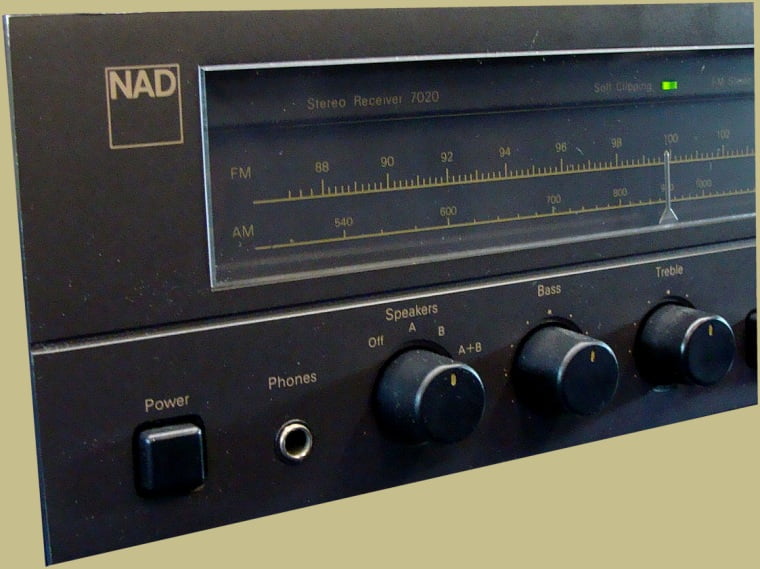
The bass and treble controls on the 7020 are designed for an effective response in the low and high frequencies but not much in the mid range which results in a more musical response overall.
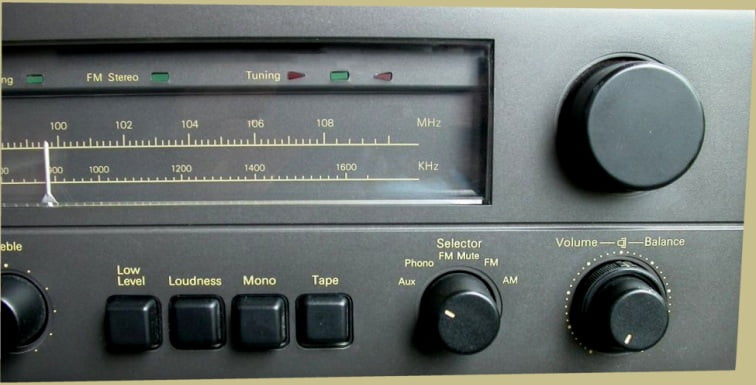
How does the 7020 perform? Excellently. The FM tuning section has a junction FET front end, three ceramic I.F. filters and a phase locked loop (PLL) multiplex decoder. These features give the 7020’s tuner high sensitivity, sharp selectivity and clean separation in the FM frequency range.

There is a matte silver version also that you don’t see very often. Perhaps it was the European version.

The phono stage on the 7020 is very good. It has a 6 transistor pre-amp stage that is quiet and has extremely low distortion. It can handle both MM and MC cartridges and it has a 107 dB dynamic range which is beneficial if you’re listening to CD’s or digitally remastered recordings.
As I mentioned above, the 20 wpc 7020 acts more like a 40 wpc receiver due to it’s wide dynamic range. NAD also uses a proprietary Soft Clipping circuit that limits waveform voltage to make sure the output transistors are never over driven.
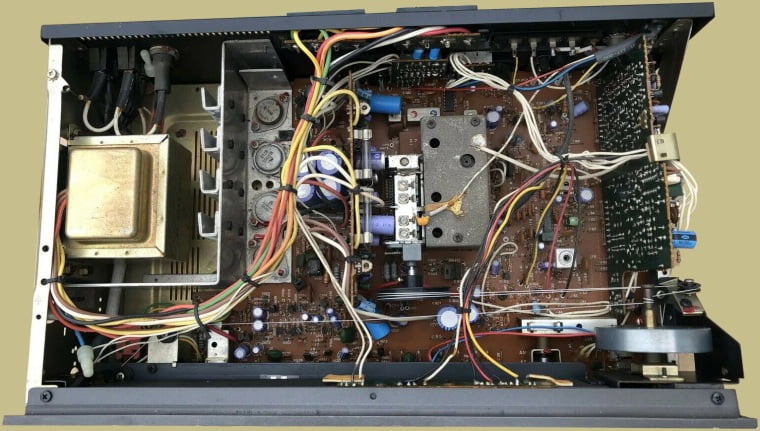
The NAD 7020 has a pretty large transformer with shielding and a strangely large tuning flywheel as well. The amp board is standing directly in the middle of the unit. The FM and Phono boards are on the right. There are a couple versions of the 7020. The above is the rev 2 version with multiple circuit boards. You can see rev 1 below which is a single large circuit board and power supply board.
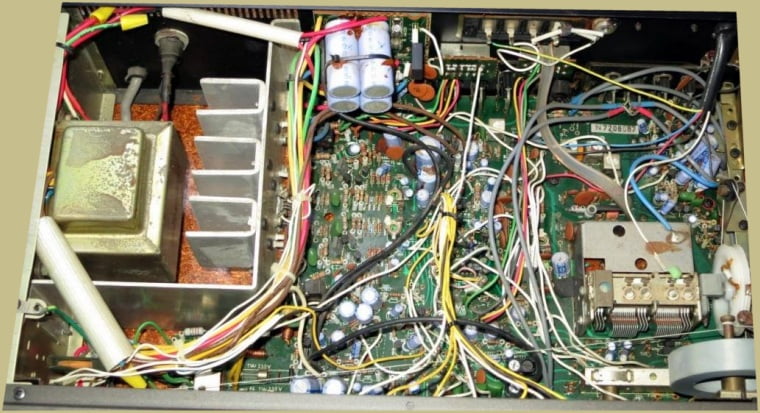
Some have stated that the rev 1 version of the 7020 has a less than stellar build quality. The circuit boards are allegedly flimsy and the traces on the boards are thin and tend to crack. The capacitors aren’t the highest quality either. Rev 2 supposedly remedied these deficiencies. Keep in mind that NAD was trying to minimize costs to keep the equipment affordable. Unfortunately that requires some trade offs. Forty years later a lot of those trade offs come back to haunt whoever owns the unit now. The rev 2 version starts at serial number 7218469. For a great look at a 7020 refurb check out the page HERE.
One of the drawbacks of the NAD 7020 is that is does not have many inputs. This is probably due to trying to fit the 3020 amp circuitry and tuner circuits into a fairly small case. Some features needed to be sacrificed in the name of space.
You can use the preamp-out and power-amp-in jacks on the rear panel for an EQ or time delay unit, or just use the 7020 as a preamp itself.

The NAD 7020 is a good receiver and, when working properly, sounds fantastic. It does have a few build flaws but its musicality and dynamic headroom make up for those deficiencies. If you don’t want to go the route of separates and get the NAD 3020 amp and a separate tuner, then the 7020 receiver is a great no-frills choice. The later 7020e (1988), which is all digital, is also a good choice.

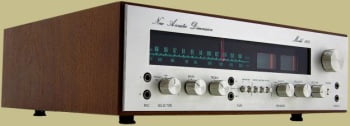
I had a rev 2 NAD 7020 and, looking back, I believe it was overrated. The tuner wasn’t THAT great (Sherwood and Kenwood are better), the understated styling was uninspiring and looked cheap, and to me other receivers sounded as good or better (Pioneer, Sherwood, Kenwood). Your mileage may vary, of course. I believe that the appearance of a piece of audio gear affects our perception and enjoyment of it, and the 7020 just wasn’t much to look at. We bought them because they were affordable, offered good value for the money back then, and seemed to be a bargain, but usually you’re happier to buy what you really like.
a first class receiver, goes as loud as my 60wpc trio ka7100,has the most wonderful, cuddly bloom in the low mid /upper bass and nice clear highs. sounds best using the lab in as this bypasses the filter system which reduces the dynamic range. go for version 2 as the right hand channel often failed on version 1. you will hear no difference with soft clipping on, so use it and the unit will last for many more years.
I was recently given a NAD 7020e by my cousin who was decluttering her home. I had actually picked it out for her some 33 years ago from London Audio (God bless Steve Glickman and may he Rest In Peace).
I asked a good friend, a hifi tech for many decades, to take a look through it and tell me what he thought. He said it was in excellent condition and the layout was beautiful with discrete wiring throughout with sizeable transformers to boot. He read up a little about it’s cult status and thought it was worth an experiment. We decided to upgrade all the rectifiers, regulators and capacitors (for the caps we used top grade nichicon), total parts was $80, but we left the tuner board alone. He ordered everything from digikey and could provide the parts list for anyone interested.
OMG… it was unbelievable!! I never in my wildest dreams thought it would turn out so well. I have a full blow NAIM system and an AudioNote for different types of music, and I could not believe how good this little NAD performed. It’s almost embarrassing to think of the money I spent compared to how good this little gem 💎 is for virtually nothing!!
Of course I won’t give up my monster system for it, but it was just stunning. I’ve always believed in used, but I cannot recommend rebuilding this unit enough. I never dreamed sound like that could come from it. It was just designed right from the start and modern components were able to take it to the next level; I wish the engineer who designed it could hear it like this… he would deserve to know the enduring brilliance of his work.
I’d love to see the parts list on this your referring to with any details.
thanks
I would love to see the parts list if you are willing to share
Can you post the parts list
I fully restored one recently. Elna Silmic II, Nichicon Mues, Wima Films, Nichicon Fine Gold, UKZ and no cost spared. Bare metal restoration. Every single circuit was addressed. It sounds quite good and is stable as can be. It included a full cosmetic restoration as well. Refinished with hammered copper. It sounds better than the comparable restored Marantz and with the hammered copper finish looks impressive as well. You can see it in the central Oregon audiophiles FB group
Do you repair? My 7020 is not functioning. No sound. I replaced the fuses (correct fuses) and burned even more components. Really like the unit but may not be worth the cost of repair.
I own a 7020e which was bought ex-display in 1998. I still use it today for one reason: I have heard nothing that comes close to the power, beauty and finesse of this receiver (least not for the money I paid). The reviews are correct; this receiver was designed to do one thing and do it well: play sound, through a variety of speaker loads. It’s taken everything I have thrown at it.. VHS/PC/console/vinyl/Tape. First-rate sound reproduction throughout. Doesn’t matter whether it’s rock, pop classical.. It takes everything in its stride.
I can also listen to it for hours without it sounding fatiguing. I cannot remember any other amp or receiver that did the same. And the 7020e was also designed to last, because I sure have given it a few bashes. That also includes yanking the headphone socket..
Some of the parts such as the pots have naturally aged and need replacing, same for some of the switches. I did remove the pot buttons and washed them, you would not think they were 35+ years old because they are pristine.
I will not part with this. Maybe I will upgrade it as others have, but I am fine with it as is. This receiver, it’s done everything it said it would on the in and more. Saved me a fortune – I’ve done away with bigger amps, as well as modern features at the expense of sound and/or build quality. When I listen to tapes late at night through the 7020e, I am in another world. The sound is on another level, it pulls you in. I am also glad I kept a load of older CD’s from the 80’s and early 90’s, due the mastering which I think is way better than what you get today.
So there’s my little story, hope you like it and it brings back some happy memories for you. AFAIC this wonderful, solid receiver is in a class of its own even today, it has been a part of most of my life and for that reason it will remain a part of my life as long as I breathe and have the privilege of listening to it.
I had a 7020 back in the day and loved it. But the FM tuner started drifting. NAD took it back and while sent it back repaired, after a few months the drifting started again. They then offered me a new 7125 at a good discount as replacement which I accepted. Have had it ever since, now for 40 years. Still works as beautifully as the day I got it. It’s matched to ADS L620 coaxial speakers, a Yamaha P350 turntable (all vintage now), a Realistic cassette tape deck and a Philips DVD player.